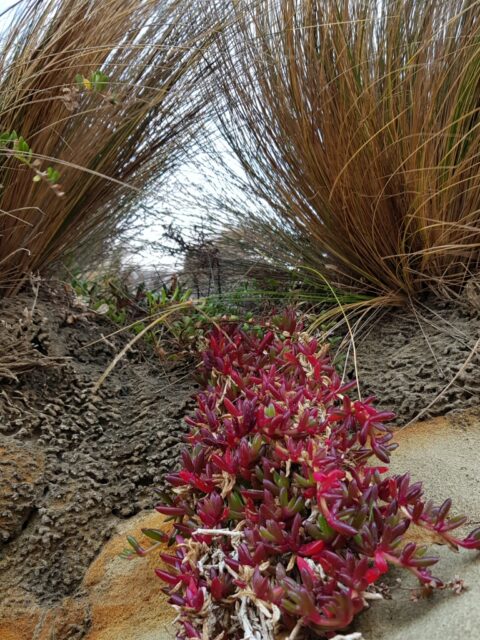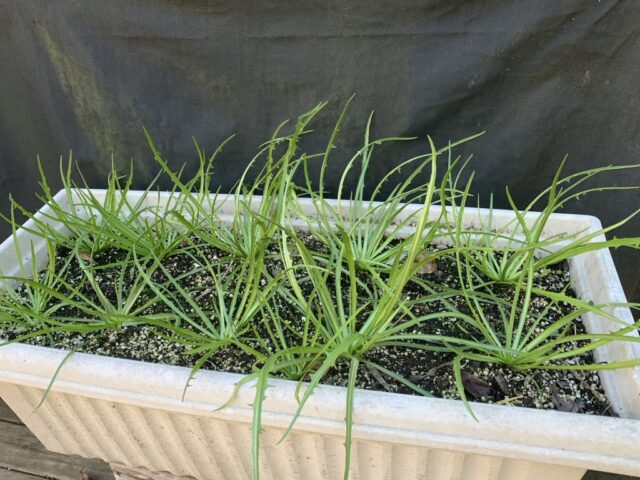The Worm Lab Onion Experiment
My informal composting and worm lab has been a busy place these past few months! During the month of June, I put onion to the test in a few of my worm farms to try to bust the myth that worms hate onion in a more graphic way for those who are interested.
The internet provides us with a wonderful tool for gathering information, but how much of the information floating around is fact? Information can be quoted and then re quoted, which can be misleading. If you search, “adding onion to worm farms” on the internet, you may find a variety of sites recommending only small amounts be added, or that it shouldn’t be added at all. I can tell you that over my many years of worm farming, I have added it in along with the other kitchen scraps and observed no ill effects. By running a few onion focused experiments, it was my hope to provide some answers, with evidence to back up the information. I posted my experiments and findings on both Instagram (@gardeningwithangus) and Facebook (Angus Stewart, public figure), for those wishing to see all the details head over to one or both to check out the results.
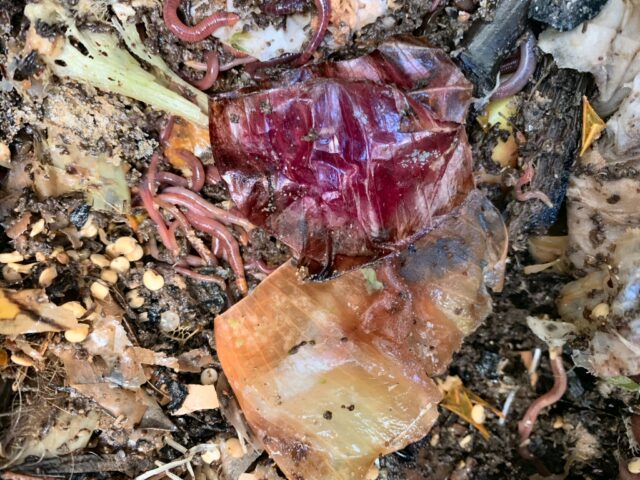 For those who don’t do social media, the onion added fresh was too sturdy and took too long to break down (as is the case when you add other whole fruits and vegetables – it always works better if you break up the food for your worm farm into as small a pieces as possible), but the worms didn’t seem to mind being around it. I chopped some up, and halved another one and both of these were put into the freezer, this helps to break down the cell walls in them. For extra ooomph, they can be put straight from the freezer into the sun as this further breaks cell walls down (which is why frost can be most destructive as the sun hits plants). The frozen and thawed onion were so much softer and broke down quicker in the worm farm, which certainly allowed the worms to chomp their way through faster. I also added another factor, where I added ripped up corrugated cardboard around the onion, and this increased the worm activity. At no time did the worms seek to get away from the onion or have any ill effects that I could see, so we called this myth busted!
For those who don’t do social media, the onion added fresh was too sturdy and took too long to break down (as is the case when you add other whole fruits and vegetables – it always works better if you break up the food for your worm farm into as small a pieces as possible), but the worms didn’t seem to mind being around it. I chopped some up, and halved another one and both of these were put into the freezer, this helps to break down the cell walls in them. For extra ooomph, they can be put straight from the freezer into the sun as this further breaks cell walls down (which is why frost can be most destructive as the sun hits plants). The frozen and thawed onion were so much softer and broke down quicker in the worm farm, which certainly allowed the worms to chomp their way through faster. I also added another factor, where I added ripped up corrugated cardboard around the onion, and this increased the worm activity. At no time did the worms seek to get away from the onion or have any ill effects that I could see, so we called this myth busted!
With the colder months in full swing and citrus now in season, I’m currently running some experimentation with adding citrus into the worm farm. This will also be posted to social media, so if you have a worm farm and want to learn more, then come and follow the journey. If you don’t yet have a worm farm or composting system, then allow me to inspire you! I’ll put the results of this in next month’s newsletter too.
Macquarie Point Edible Precinct
For a while now, I have been involved in the development of the Macquarie Point Project in my new home state of Tasmania. This is a 9 hectare waterfront site, which, in its previous life as a rail head adjoining the commercial port in Hobart, was subject to substantial environmental degradation from the various industrial workings there over more than 150 years. It is now being remediated and re-invented into an impressive new area for locals and visitors. The project I am involved in there is called the Edible Precinct, a wonderful experiment in sustainable urban farming which has purposefully included native Tasmanian bush food plants growing along side more commonly known exotic edibles. In April this year, Mac Point was officially opened, so I am now able to share a little more about the wonderful workings going within the grounds. The precinct I am involved with is really starting to build and take shape as a space to showcase how the local businesses such as cafes, restaurants and the craft brewery on site can ‘close the organic loop’ with some good innovative ideas and products. The plants and soil of the Edible Precinct are fed and nourished using worm castings, tea and compost collected on site from the multiple worm farm and composting systems. Local cafes are now donating their organic waste to use, and the worms and soil bacteria do their stuff and turn it into rich organic fertiliser. The organic matter is allowed to break down naturally, rather than ending up in landfill where it would be buried and wasted. Once everything is broken down, we are left with a beautiful, healthy, microbe rich top soil, which is ideal for use in growing edibles. Now that’s what I call sustainability! The processes being applied here in Mac Point can be done in any urban setting with the right planning and execution. The fact that Mac Point was once a big, industrial area, but is now a thriving garden can inspire us all!
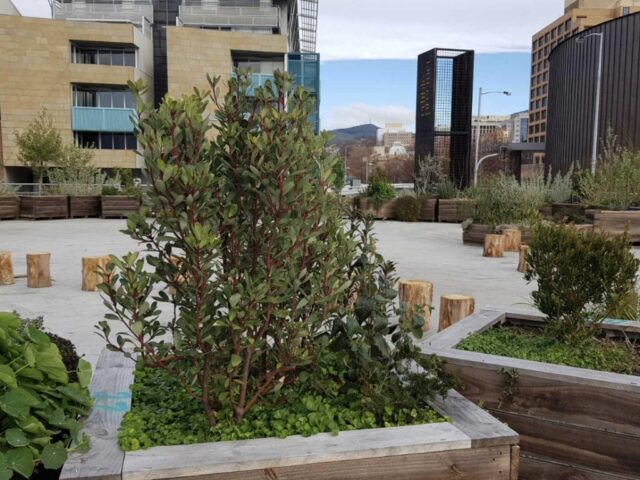 Happy Tasmanian Pepperberry tree at Macquarie Point
Happy Tasmanian Pepperberry tree at Macquarie Point
My good friend, soil scientist Simon Leake gave valuable advice to the project to design the soil as well as the raised wicking beds we are using which are made from modified apple picking bins (seen above), a salute to Tasmanian horticultural history. Simon is my co-author for our book Grow Your Own, How To Be An Urban Farmer, which gives advice on how to do all of this on a smaller home scale. We feel that this is so important for a few reasons- sustainability of our urban areas with food production, the boost to mental health from the act of gardening, the boost to physical health by being more active. Creating your own fresh vegies acts as a catalyst to cooking more healthily too, as you go in search of recipes to incorporate your produce. And taking the organic matter out of landfill to produce topsoil should be a no brainer, so the more projects like Macquarie Point the better, to showcase and encourage these all important ideas. With spring coming up, lets crank up the composting, the worm farming, and the vegie gardening! Lets put all the vegie and fruit scraps and the paper and cardboard into creating beautiful healthy soil!
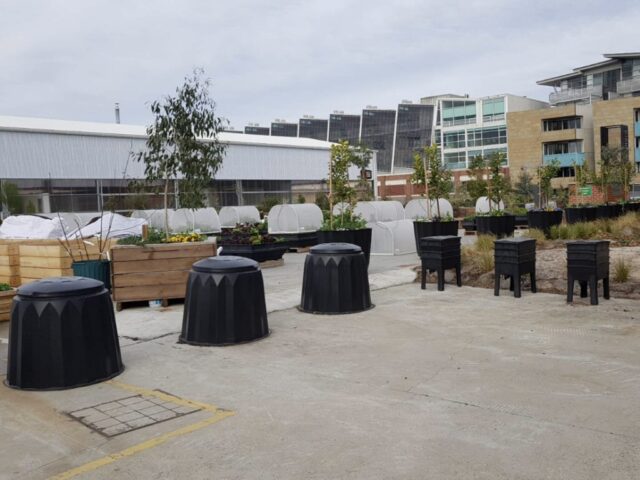 Tumbleweed composters and worm farms hard at work
Tumbleweed composters and worm farms hard at work
Bush food learning
I have long had an interest in bush foods and I pay my respects to the Aboriginal people of Australia with regard to their heritage and history of custodianship of the flora. I am currently working at the Edible Precinct at Macquarie Point in Hobart with various Tasmanian Aboriginal people such as Kitana Mansell to learn more about the bush foods of Tasmania and I will be writing more on this subject in future newsletters. To whet your appetite (please forgive the Dad joke) one of my early favourites from the Tasmanian flora is the Roundleaf (or Coastal) Noonflower, Disphyma Crassifolium. This hardy native succulent grows prolifically right on the coast where it picks up salt spray to give it some extra flavor. I use it in stir fries and soups where it provides a fabulous crunchy texture and salty flavour. It grows easily in well drained situations and we already have a great crop of it growing in the Edible Precinct (see above article) where it trails down the outside of the wicking beds, making a lovely ornamental plant as it develops a fiery burgundy foliage colour through the winter. It is also incredibly easy to strike from cuttings as are many succulents.
In other bush food news from the mainland, I started off a yam daisy (Murnong) project about 5 years ago, when I was living on the central coast of NSW, with a couple of plants brought back from a trip to Victoria. They were grown on and a few seeds were able to be saved from them. And the yam daisy project was off and running! Since my move to Tasmania, family still in NSW are continuing on with them, and this year I was able to offer some seed on my website shop…..it sold out in a day.
The yam daisy plant is an interesting one, and reading Bruce Pascoe’s informative book, Dark Emu, has made me want to explore it a bit more. There have been a few hiccups with growing them, with drought, chickens, rabbits and rodents taking their toll along the way, but I hope to be able to regularly offer seed so more people can grow this significant little plant. I highly recommend you read Dark Emu to see why.
If you can find seed or plants, our best success has been growing them in a wicking bed and large self watering troughs in a sunny spot, though we have had seed produced in shadier conditions in summer. A soil with plenty of organic matter and regular moisture produces strong healthy plants, but neglected plants still survived to set seed. I’m still yet to eat any home produced tubers, as the aim has been to maximise the seed produced, but hope to this year. I will update you as the project continues.

